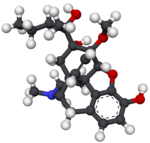Etorphine
 | |
 | |
| Clinical data | |
|---|---|
| AHFS/Drugs | International Drug Names |
| ATCvet code | |
| Legal status | |
| Legal status |
|
| Identifiers | |
| |
| CAS Number | |
| PubChemCID | |
| IUPHAR/BPS | |
| DrugBank | |
| ChemSpider | |
| UNII | |
| KEGG | |
| ChEBI | |
| ChEMBL | |
| CompTox Dashboard(EPA) | |
| ECHA InfoCard | 100.035.017 |
| Chemical and physical data | |
| Formula | C25H33NO4 |
| Molar mass | 411.542g·mol−1 |
| 3D model (JSmol) | |
| |
| |
Etorphine(M99) is a semi-syntheticopioidpossessing ananalgesicpotency approximately 1,000–3,000 times that ofmorphine.[1]It was first prepared in 1960 fromoripavine,which does not generally occur inopium poppyextract but rather the related plantsPapaver orientaleandPapaver bracteatum.[2]It was reproduced in 1963 by a research group atMacFarlan SmithinGorgie,Edinburgh,led by Kenneth Bentley.[3]It can be produced fromthebaine.[4]
Veterinary use
[edit]Etorphine is available legally only forveterinaryuse and is strictly governed by law. It is often used to immobilizeelephantsand other large mammals.Diprenorphine(Revivon) is an opioid receptor antagonist that can be administered in proportion to the amount of etorphine used (1.3 times) to reverse its effects. Veterinary-strength etorphine is fatal to humans. For this reason the package as supplied to vets always includes the human antidote along with the etorphine.
The human antidote is generallynaloxone,not diprenorphine, and is always prepared before the preparation of etorphine to be immediately administered following accidental human exposure to etorphine. TheLD50in humans is 3 μg which led to the requirement that the medicine include an equal dose of an antidote,diprenorphineornaloxone.
One of its main advantages is its speed of operation, and more importantly, the speed thatdiprenorphinereverses its effects. The high incidence of side effects, including severe cardiopulmonary depression, has caused etorphine to fall into disfavor in general veterinary practice. However, its high potency, combined with the rapid action of both etorphine and its antagonist, diprenorphine, means that it has found a place for use in the capture of large mammals, such as rhinoceroses and elephants, where rapid onset and rapid recovery are both very important. The high potency of etorphine means that sufficient etorphine can be administered to large wild mammals by projectile syringe (dart).
Large Animal Immobilonis a combination of etorphine plusacepromazinemaleate. An etorphine antidoteLarge Animal Revivoncontains mainly diprenorphine for animals and a human-specificnaloxone-based antidote, which should be prepared prior to the etorphine. A 5–15 mg dose is enough to immobilize anAfrican elephantand a 2–4 mg dose is enough to immobilize ablack rhinoceros.[5]
Pharmacology
[edit]Etorphine is a potent, non-selectivefull agonistof theμ-,δ-,andκ-opioid receptors.[6][7]It has a weakaffinityfor thenociceptin receptor.[8]Etorphine has an LD50of 3 μg in humans.[9]
Legal status
[edit]InHong Kong,etorphine is regulated under Schedule 1 of Hong Kong's Chapter 134Dangerous Drugs Ordinance.It can be used legally only by health professionals and for university research purposes. The substance can be given by pharmacists under a prescription. Anyone who supplies the substance without prescription can be fined $10,000 (HKD). The penalty for trafficking or manufacturing the substance is a $5,000,000 (HKD) fine and life imprisonment. Possession of the substance for consumption without license from the Department of Health is illegal with a $1,000,000 (HKD) fine and/or 7 years of jail time.[10]
In theNetherlands,etorphine is a Schedule I drug of theOpium Law.It is used only for veterinary purposes in zoos to immobilize large animals.[11]
In the US, etorphine is listed as aSchedule Idrug with an ACSCN of 9056, although itshydrochloridesaltis classified asSchedule IIwith an ACSCN of 9059.[12]
In the UK, under theMisuse of Drugs Act 1971,etorphine is controlled as a Class A substance.[13]
In ItalyEtorphineis illegal, as are the parent compoundsDihydroetorphineandAcetorphine.(Datas from 2022)[14]
See also
[edit]- 6,14-Endoethenotetrahydrooripavine- the central nucleus of allBentley compoundopioids under which class etorphine falls
- Dihydroetorphine– a close analog of etorphine that has been used as an opioid painkiller for human usage in China
- Thienorphine
- Opioid potency comparison
References
[edit]- ^Bentley KW, Hardy DG (June 1967). "Novel analgesics and molecular rearrangements in the morphine-thebaine group. 3. Alcohols of the 6,14-endo-ethenotetrahydrooripavine series and derived analogs of N-allylnormorphine and -norcodeine".Journal of the American Chemical Society.89(13): 3281–3292.doi:10.1021/ja00989a032.PMID6042764.
- ^Aggrawal A (1995)."Chapter 3 Opium: the king of narcotics".Narcotic Drugs.New Delhi: National Book Trust. pp. xvi+161.ISBN81-237-1383-5.
- ^Bentley KW, Hardy DG (1963). "New potent analgesics in the morphine series".Proceedings of the Chemical Society.220:189–228.doi:10.1039/PS9630000189.
- ^Huang XR, Srimurugan S, Lee GH, Chen C (February 2011)."A Facile Synthesis and Structural Verification of Etorphine and Dihydroetorphine from Codeine".Journal of the Chinese Chemical Society.58(1): 101–107.doi:10.1002/jccs.201190048.ISSN0009-4536.
- ^"Etorphine HCl".Veterinary medicine for wildlife: immobilisation medicine for animals zoo animals.Zoo Pharm. Archived fromthe originalon 2016-09-08.Retrieved2013-10-11.
- ^Pasternak G (17 April 2013).The Opiate Receptors.Springer Science & Business Media. pp. 444–.ISBN978-1-60761-990-1.
- ^Gharagozlou P, Hashemi E, DeLorey TM, Clark JD, Lameh J (January 2006)."Pharmacological profiles of opioid ligands at kappa opioid receptors".BMC Pharmacology.6(1): 3.doi:10.1186/1471-2210-6-3.PMC1403760.PMID16433932.
- ^Hawkinson JE, Acosta-Burruel M, Espitia SA (February 2000). "Opioid activity profiles indicate similarities between the nociceptin/orphanin FQ and opioid receptors".European Journal of Pharmacology.389(2–3): 107–114.doi:10.1016/S0014-2999(99)00904-8.PMID10688973.
- ^Riviere JE, Papich MG (2009-03-17). Riviere JE, Papich MG (eds.).Veterinary Pharmacology and Therapeutics.John Wiley & Sons. p. 32.ISBN978-0-8138-2061-3.
- ^"Hong Kong e-Legislation".elegislation.gov.hk.Retrieved2022-03-30.
- ^"Opiumwet".Ministerie van Binnenlandse Zaken en Koninkrijksrelaties(in Dutch).Retrieved2022-03-30.
- ^"Etorphine".PubChem.U.S. National Library of Medicine. CID 26721.Retrieved2022-03-30.
- ^"List of most commonly encountered drugs currently controlled under the misuse of drugs legislation".GOV.UK.Retrieved2022-03-30.
- ^"Tabelle delle sostanze stupefacenti e psicotrope".Ministero della Salute(in Italian).Retrieved2022-04-09.
External links
[edit]- Opioidspage on etorphine
- Etorphine: Molecule of the Month
